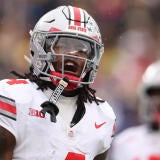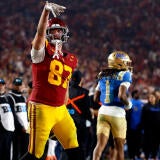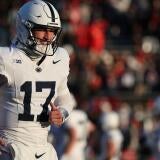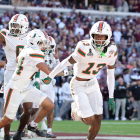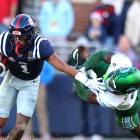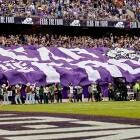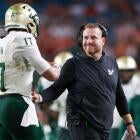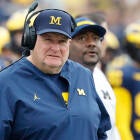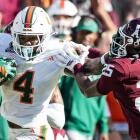Inside College Football: Auburn's latest transfer QB brings back 2013 feelings
Jarrett Stidham leads a slew of transfer quarterbacks who will make an impact in 2017
There is a big reason Gus Malzahn didn't let his starting quarterback speak with the media until this month.
Call it the Jeremy Johnson Effect.
Two years ago, Johnson, then a junior, was awarded Heisman status having thrown all of 78 career passes. As you may recall, it didn't end well. Johnson lasted about three games as a starter in 2015.
"I think he had a lot of pressure on him. I think that kind of hurt him," Auburn center Austin Golston said. "… He hadn't ever really started. It was kind of a negative thing to do to him. I don't think that was the right way to go about it."
So in order to diffuse a possible Jarrett Stidham Effect, the Baylor transfer was held out of media scrums until being named the starter this month. Not that it would have made any difference.
Following a recent interview, it was obvious Stidham wasn't going to spill any state secrets. But before starting a game at Auburn, he's more recognizable strolling across campus than he ever was at Baylor
"That's something I've kind of had to realize coming from Baylor to Auburn," Stidham said. "Fans and stuff like that, here in Alabama, it's a very big deal whether you play for Auburn or Alabama.
"It's definitely different, the culture down here."
Ya think? The mere "news" of Stidham starting forces us to consider a subcategory in the Year of the Quarterback.
You can have your Sam Darnold, Josh Rosen and Josh Allen. How about the Year of the Transfer Quarterback?
As a Baylor freshman (mostly) backup in 2015, Stidham tossed an average of one touchdown every nine throws.
When the Baylor scandal hit, the Stephenville, Texas, native became one of the most valuable quarterback free agents available.
Instead of rushing to get into his next program, Stidham stayed in Waco, Texas, and took online classes at McClennan County Community College.
Without taking a snap, he became the No. 1 JUCO quarterback prospect.
"Everything was happening so fast. The season was right around the corner," Stidham told me. "I really had no idea where I wanted to go.
"I didn't think I was really going to be able to get a good spot [within that time frame]. I decided to take the fall off and get my associates degree. I wanted this to be the last time this would ever happen."
Auburn fans will be interested about this nugget of self-discipline from their new quarterback: He crammed studies for his six classes into Monday and Tuesday at McClennan so he would be free the rest of the week.
"I had four- or five-day [weekends]," he said.
Stidham makes Auburn's offense the best since that magical 2013 season with Nick Marshall.
Johnson didn't work out. Under Sean White last season, Auburn finished tied for 91st in pass completions of at least 20 yards. Without throwing a pass, Stidham went from 50-1 to win the Heisman to tied for fourth at one Las Vegas sportsbook.
With Malzahn giving up play-calling duties, new offensive coordinator Chip Lindsey and Stidham are the hottest couple in town.
"He's kind of taking the next step as a head coach," Lindsey said. "People forget he really changed offenses in the SEC."
The marriage of Auburn and Stidham makes it easier to answer a confusing question in 2016: Who is the SEC's second-best team?
It's the Tigers, who have a better quarterback compliment to Malzahn's power-run centric spread. Stidham can run it a little bit, too, but he knows who he's following.
"I'm not going to sit here and say I'm going to bust one down the sideline for 75 yards like Nick Marshall or Cam Newton," Stidham said. "I like to keep the defense honest. If it's 3rd and 14 or 3rd and 15 and they're in a certain coverage, I can pick that up, maybe a few more."
Be still beating Tiger hearts. It's about to get good again -- or at least familiar -- on The Plains.
"The last time I felt this way was 2013," one Auburn coach said.
Rating the transfer quarterbacks
After Stidham, it goes like this …
2. Kyle Allen, Houston: One half of the worst December of Kevin Sumlin's career in 2015. Along with fellow five-star Kyler Murray -- now at Oklahoma -- Allen left Texas A&M within a couple of weeks. He turned up in Houston as the heir apparent to Greg Ward Jr.. That's happened, but his offensive coordinator (Major Applewhite) is now his coach. Early word is that Allen is killing it giving the Cougars to a chance to keep the Herman momentum going.
3. Will Grier, West Virginia: Florida's once-disgraced leader couldn't be happier. He's in Dana Holgersen's powerful offense with a load of receivers. Don't be surprised if Grier throws for 4,000 yards and 35 touchdowns.
4. Brandon Harris, North Carolina: Yeah, he never fit at LSU. There were rumblings about Harris' ability to make savvy reads. Larry Fedora is one of the more underrated offensive minds in the country. One guess is that he'll simplify the offense for Harris with designed runs making it unlikely the Tar Heels are going away in the ACC Coastal Division.
5. Max Browne, Pittsburgh: It's hard to remember Browne started the first three games of the season for USC before Darnold took over in 2016. Even though he lost the job, Browne completed a respectable 62 percent in those games. For the second straight year, Panthers' coach Pat Narduzzi goes the transfer route to find his starter (Nathan Peterman from Tennessee).
Shrinking halftimes
Say goodbye to a couple of college football staples if conferences really follow through with their intention of shortening games.
The Pac-12 will limit halftimes to 15 minutes in select nonconference games this season.
There is already a national initiative in other conferences to hold halftimes down to a "hard 20" minutes.
The first, best casualty to make sure that reduction takes is the end of the coaches' halftime interview. Face it, they don't really add much unless John L. Smith is on a rampage.
Also, band directors ought to consider some self-editing. In other words, say goodbye to the State U's overwrought salute to "Star Wars." If this initiative holds together, there will barely be enough time to dot the "I" at Ohio State.
"The difference between pro and college is band performances," said Craig Thompson, the Mountain West commissioner. "In the NFL, they blow that horn and say, 'There is one minute to kickoff. Get your drink and get back to the stands.' We're all in favor of things that attract people to the stands."
Understand, the networks are still going to get their halftime commercials in. That isn't going to change. What it means is less (insert network here)'s on-air halftime show. Don't make the average fan choose between a quick beer run and Lee Corso.
The Pac-12 pilot program will apply only at nonconference games hosted by conference schools and televised on the Pac-12 Network. The league's 15-minute limit is five minutes shorter than normal 20-minute halftimes and could raise concerns about player safety.
"We don't have any data to say it's not [harmful]," said veteran Arizona trainer Randy Cohen, who was consulting on the change. "The whole idea is, it's a pilot program. We'll look at the data and see."
Game length became a national discussion in college football after games last season reached an average of three hours, 24 minutes, an all-time high.
That usual 20-minute halftime typically ran "3-5 minutes" long because of TV/radio coach interviews, according to Steve Shaw, the new secretary-editor of the rules committee.
Darth Vader died. Perhaps so do bloated halftimes.
Quotes of the week
- Notre Dame's Brian Kelly on having to fundraise during the season: "It f---ed up last year's team," he told Bleacher Report.
- Lane Kiffin, when I asked him how he was able to track and land so many transfers: "Google search."


